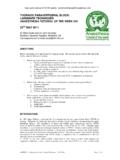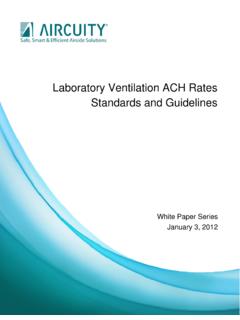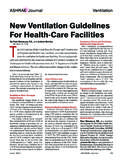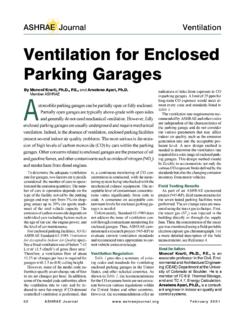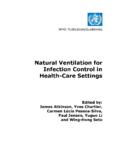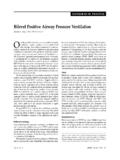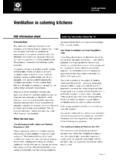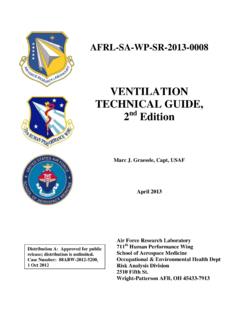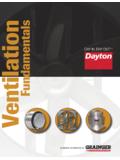Transcription of Two Steps forward in Ventilation - FRCA
1 Two Steps forward in VentilationErnst BahnsBecause you careImportant Note:Medical knowledge changes constantly as a result of new research and clinicalexperience. The author of this introductoryguide has made every effort to ensure thatthe information given is completely up todate, particularly as regards applicationsand mode of operation. However,responsibility for all clinical measures mustremain with the s address:Dr. Ernst Bahns, Dr gerwerk Aktiengesellschaft, Moislinger Allee 53/55, 23542 L rights, in particular those of duplicationand distribution, are reserved byDr gerwerk AG. No part of this work maybe reproduced or stored in any form usingmechanical, electronic or photographicmeans, without the written permission ofDr gerwerk Two Steps forward in Intensive-Care VentilationAn introductory guide to Evita ventilation4 IntroductionModern ventilators enable therapy to be specifically directed at awide range of respiratory disorders and can do far more than justmaintain vital functions.
2 The continued development of pneumaticsand electronics and, above all, of computer technology means thattoday selective measures can be taken to manage problems withthe control and mechanics of Ventilation and with gas there has been so much technical development, it isextremely difficult to keep track of all the therapeutic measuresavailable. For instance, there are now more than a dozen differentventilation modes. The accompanying expansion in the number ofterms used has tended to create confusion rather than clarity. It is,therefore, essential to ask the question:Do we really need yet another new Ventilation mode?The answer can only be yes , provided that an attempt is alsomade to tackle some of the confusion.
3 Complexity could be reduc-ed, if it is possible to use the same mode from the beginning ofventilation through to success of Ventilation therapy depends on several factors. It isan important factor that Ventilation is provided with minimum inter-vention at the right time and with the right intensity. Ventilationtherapy should adapt to the changing needs of the patient. Ideally,such a universal Ventilation mode would accompany the patientthroughout Ventilation introductory guide covers two basic aspects of modern inten-sive-care Ventilation . It describes new approaches for hospital staffand presents new information on the effect on patients.
4 Whereverpossible the guide avoids the use of abbreviations and of the main principles in the design of Evita was to simplifyventilation. Following the same principle, this introductory guideaims to make Ventilation easier to understand and easier to use. 6 IntroductionOutlineThe BIPAP1)(Biphasic Positive Airway Pressure) Ventilation modeis a modern Ventilation method which has been an important fea-ture of the Evita ventilator since it was first introduced. This guideis designed to make the subject easy to which has been published in medical literature on thetheory and clinical applications of BIPAP Ventilation is summarizedin simplified form in this introductory guide to assist busy both the theory and the practice have developed from well-known principles, BIPAP does not demand that users think alongentirely new lines.
5 All that is required is an interest in new introductory guide is divided into four sections, as follows:1. Description of BIPAP:This section gives a brief outline of how BIPAP was developedand how it is classified according to BIPAP and conventional Ventilation :This section compares BIPAP with standard mandatory ventilationand spontaneous Setting BIPAP:This section describes how BIPAP operates in the Evita 1 ven-tilator and how this has been simplified for the Evita 2 Using BIPAP:This section deals with intensive-care Ventilation using BIPAP,gives instructions for weaning and discusses special bibliography is provided at the end of the ) Trademark under license7 Fig.
6 1: Aims and structure of the BIPAP sections are divided into sub-sections. Each sub-sectiondeals with a separate topic on two pages with text and to BIPAPBIPAP and conventional ventilationBIPAP operationVentilating and weaning with BIPAPTo the patient with regard to therapyTo the staff with regard to handling?Benefits8 BIPAP definitionBIPAP in briefBIPAP Ventilation ranges across the whole spectrum from purelymechanical Ventilation to purely spontaneous breathing. This rangecan cover the entire course of therapy from intubation to the com-pletion of weaning. For this reason BIPAP has come to be knownas a universal Ventilation mode .In contrast to conventional Ventilation , BIPAP does not featureseparate modes for controlled Ventilation and spontaneous breath-ing, but merely variations of the same Ventilation mode.
7 The boundaries between the variations are completely flexible as they are defined primarily by the patient's ability to breathe diagram in Figure 2 shows that the lung being ventilated withBIPAP can be thought of as a balloon with two forces acting on positive pressure generated by the ventilator, combined withthe negative pressure produced by the inspiratory muscles, pro-duce a flow. In BIPAP Ventilation these two forces never opposeone 's broad spectrum gives staff more freedom and flexibilityfor Ventilation 2: Mechanical model of the lungs illustrating BIPAP of the lungs involves two forces. The ventilator gene-rates a positive pressure whilst the inspiratory muscles produce anegative pressure.
8 The two forces combine to produce a changeof volume in the definition Respiratory muscles (breath)LungvolumeVentilator (pressure)10 BIPAP definitionA story in brief:The origins of BIPAPBIPAP was first described in a study published in 1985 by a groupled by M. Baum and H. Benzer and it was incorporated in the Evitaventilator in the same year. Earlier studies conducted by Downs etal. used the term APRV (Airway Pressure Release Ventilation ) [7] todescribe a method of Ventilation which used the same mechanicalprinciple as BIPAP, but started from a different authors describe BIPAP as pressure-controlled ventilationwith freedom of respiration and spontaneous breathing on twoCPAP levels.
9 Figure 3 is from the study published by Baum et al. [1].The workgroup of Baum represented a new approach to ven-tilation techniques. Before 1989, though Ventilation modesemployed a mixture of mechanical Ventilation and spontaneousbreathing (augmented Ventilation ), they were all based on thesame principle for maintaining minimum Ventilation , namely mechan-ical breaths alternating with spontaneous clinical problems which arose from alternating betweenmechanical Ventilation and spontaneous breathing were the start-ing point for the development of BIPAP: patients often failed toaccept the enforced respiratory rate or the interruption of theirspontaneous breathing by the mandatory and Benzer realized that BIPAP was particularly importantfrom the clinical point of view because Ventilation was accuratelymatched to the patient's spontaneous breathing and because itwas straightforward to use.
10 These advantages were thought to beparticularly significant for weaning, because there was no alter-nation between pure mechanical Ventilation and augmented ven-tilation. Decisions about when to start the weaning processbecome totally unnecessary with the new BIPAP mode weaningis possible right from the 3: Schematic view of BIPAP figure shows the principle of mixed mechanical Ventilation andspontaneous breathing. In contrast to conventional Ventilation ,mechanical and spontaneous breathing occur at the same time definitionPBIPAPtPtSpontaneous breathingtPPressure-controlledventilatio n12 BIPAP definitionSimply a matter of form:A versatile Ventilation modeBIPAP can take many forms depending on how it is being the one hand, it can provide pressure-controlled Ventilation in asystem which always permits unrestricted spontaneous breathingbut it can also be viewed as a CPAP system with time-cycledchanges between different CPAP there are two processes involved when ventilating thelungs with BIPAP as shown in Figure 2.









